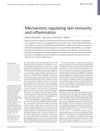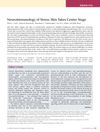The Importance of the Neuro-Immuno-Cutaneous System on Human Skin Equivalent Design
August 2019
in “
Cell Proliferation
”
TLDR Human skin models are essential for studying skin's sensory, immune, and nervous system interactions.
The document discussed the neuro-immuno-cutaneous (NIC) system's critical role in skin health, pathology, and human skin equivalent (HSE) design, emphasizing its interactions with the nervous and immune systems. It highlighted the importance of including NIC components in HSEs to better understand and treat skin conditions like psoriasis, atopic dermatitis, and vitiligo. Despite advancements, challenges such as rejection, scarring, and lack of functional integration persisted. The study underscored the need for comprehensive in vitro models that incorporate various cell types and extracellular matrix components to mimic the complexity of human skin, improve treatment, and potentially replace animal testing. Future research was suggested to focus on bio-active materials and bioprinting techniques to enhance wound healing and neural integration.










